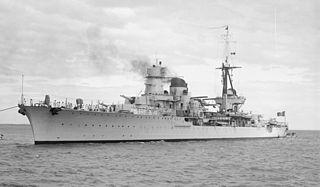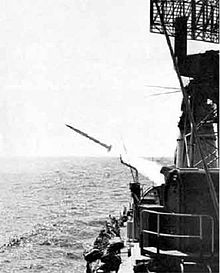
A cruiser is a type of warship. Modern cruisers are generally the largest ships in a fleet after aircraft carriers and amphibious assault ships, and can usually perform several operational roles from search-and-destroy to ocean escort to sea denial.

The Battle of Calabria known to the Italian Navy as the Battle of Punta Stilo, was a naval battle during the Battle of the Mediterranean in the Second World War. Ships of the Regia Marina were opposed by vessels of the Mediterranean Fleet. The battle took place 30 nmi to the east of Punta Stilo, Calabria.

HMS Neptune was a Leander-class light cruiser which served with the Royal Navy during World War II. Neptune was the fourth ship of its class and was the ninth Royal Navy vessel to carry the name.

The Regia Marina (RM) or Royal Italian Navy was the navy of the Kingdom of Italy from 1861 to 1946. In 1946, with the birth of the Italian Republic, the Regia Marina changed its name to Marina Militare.

Giovanni delle Bande Nere was an Italian light cruiser of the Giussano class, which served in the Regia Marina during World War II. She was named after the eponymous 16th-century condottiero and member of the Medici family. Her keel was laid down in 1928 at Cantieri Navali di Castellammare di Stabia, Castellammare di Stabia; she was launched on 27 April 1930, and her construction was completed in 1931. Unlike her three sisters, the finish and workmanship on the vessel were not rated highly. She was sunk on 1 April 1942 by the British submarine HMS Urge.

The Condottieri class was a sequence of five light cruiser classes of the Regia Marina, although these classes show a clear line of evolution. They were built before World War II to gain predominance in the Mediterranean Sea. The ships were named after condottieri of Italian history.

Trieste was the second of two Trento-class heavy cruisers built for the Italian Regia Marina. The ship was laid down in June 1925, was launched in October 1926, and was commissioned in December 1928. Trieste was very lightly armored, with only a 70 mm (2.8 in) thick armored belt, though she possessed a high speed and heavy main battery of eight 203 mm (8 in) guns. Though nominally built under the restrictions of the Washington Naval Treaty, the two cruisers significantly exceeded the displacement limits imposed by the treaty. The ship spent the 1930s conducting training cruises in the Mediterranean Sea, participating in naval reviews held for foreign dignitaries, and serving as the flagship of the Cruiser Division. She also helped transport Italian volunteer troops that had been sent to Spain to fight in the Spanish Civil War return to Italy in 1938.

Trento was the first of two Trento-class cruisers; they were the first heavy cruisers built for the Italian Regia Marina. The ship was laid down in February 1925, launched in October 1927, and was commissioned in April 1929. Trento was very lightly armored, with only a 70 mm (2.8 in) thick armored belt, though she possessed a high speed and heavy main battery of eight 203 mm (8 in) guns. Though nominally built under the restrictions of the Washington Naval Treaty, the two cruisers significantly exceeded the displacement limits imposed by the treaty.

The Kasuga-class cruiser was a class of two armored cruisers of the Imperial Japanese Navy (IJN) based on the Giuseppe Garibaldi-class cruisers developed by Italy at the end of the 19th century.

Luigi Cadorna was an Italian Condottieri-class light cruiser, which served in the Regia Marina during World War II; named after Italian Field Marshal Luigi Cadorna who was commander in Chief of the Italian Army during World War I.

Armando Diaz was a light cruiser of the Condottieri class and the sister-ship of the Luigi Cadorna. She served in the Regia Marina during World War II. She was built by OTO, La Spezia, and named after Armando Diaz, an Italian Field Marshal of World War I.

Raimondo Montecuccoli was a Condottieri-class light cruiser serving with the Italian Regia Marina during World War II. She survived the war and served in the post-war Marina Militare until 1964.

Emanuele Filiberto Duca d'Aosta was an Italian light cruiser of the fourth group of the Condottieri-class, that served in the Regia Marina during World War II. She survived the war, but was ceded as war reparation to the Soviet Navy in 1949. She was finally renamed Kerch and served in the Black Sea Fleet until the 1960s.

Eugenio di Savoia was a Condottieri-class light cruiser, which served in the Regia Marina during World War II. She survived the war but was given as a war reparation to the Hellenic Navy in 1950. Eugenio di Savoia was renamed Elli and served until 1965.

Luigi di Savoia Duca degli Abruzzi was an Italian Duca degli Abruzzi-class light cruiser, which served in the Regia Marina during World War II. After the war, she was retained by the Marina Militare and decommissioned in 1961. She was built by OTO at La Spezia and named after Prince Luigi Amedeo, Duke of the Abruzzi, an Italian explorer and Admiral of World War I.

The Giuseppe Garibaldi-class cruisers were a class of ten armoured cruisers built in Italy in the 1890s and the first decade of the 20th century. The ships were built for both the Royal Italian Navy and for export. With the class being named for Italian unifier and nationalist Giuseppe Garibaldi.

Francesco Ferruccio was a Giuseppe Garibaldi-class armored cruiser built for the Royal Italian Navy in the first decade of the 20th century. The ship made several deployments to the Eastern Mediterranean and the Levant during her career. At the beginning of the Italo-Turkish War of 1911–12 she bombarded Tripoli and then Beirut in early 1912 before being transferred to Libya. During World War I, Francesco Ferruccio's activities were limited by the threat of Austro-Hungarian submarines and she became a training ship in 1919. The ship was struck from the naval register in 1930 and subsequently scrapped.

Varese was a Giuseppe Garibaldi-class armored cruiser built for the Royal Italian Navy in the 1890s. The ship made several deployments to the Eastern Mediterranean and the Levant before the start of the Italo-Turkish War of 1911–12. She supported ground forces in the occupations of Tripoli and Homs in Libya. Varese may have bombarded Beirut and did bombard the defenses of the Dardanelles during the war. She also provided naval gunfire support for the Italian Army in Libya. During World War I, the ship's activities were limited by the threat of Austro-Hungarian submarines and Varese became a training ship in 1920. She was struck from the naval register in 1923 and subsequently scrapped.

Luigi Biancheri was an Italian admiral during World War II.





















